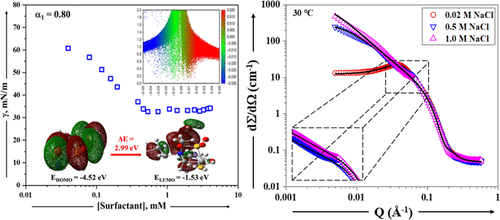揭示两性离子-阴离子混合表面活性剂体系中胶束化的流变响应和分形维数
IF 3.9
2区 化学
Q2 CHEMISTRY, MULTIDISCIPLINARY
引用次数: 0
摘要
本研究独特地揭示了选择性两性离子-阴离子混合表面活性剂体系在水溶液和不同盐存在下的分层自组装和复杂的胶束转变。结合张力学、流变学和小角中子散射(SANS)实验,研究了选择性混合胶束体系中的这些纳米级转变。在室温下测定了单体系和混合体系的临界胶束浓度(CMC),并利用Rubingh正则溶液理论(RST)计算了在特定摩尔分数下表现良好协同作用的相互作用参数(β)。同样,计算了各种热力学参数,如前田胶束自由能(ΔGMaeda)、胶束自由能(ΔGM)和吸附自由能(ΔGads)。采用Gaussian 09W软件包进行密度泛函理论(DFT)计算,并使用Gauss View 6.0进行可视化处理,得到不同的量子化学描述符,支持阴离子表面活性剂在被测体系中有利于两性离子表面活性剂胶束化的显著影响。此外,所获得的降低密度梯度(RDG)和非共价相互作用(NCI)使人们能够理解其中涉及的协同相互作用,这一点得到了二维核Overhauser增强光谱(2D-NOESY)的证实,该光谱探索了所研究胶束溶液中的自组装机制。流变参数,如弹性模量(G ')和粘度模量(G″),描述了流体、粘性和凝胶形成等不同的溶液行为,从而归因于粘弹性,特别是在盐存在的情况下。SANS方法推断胶束生长具有各种形态转变,从球体,椭球和圆柱体。有趣的是,在检测的系统中还显示了分形维数(Dm),这类表面活性剂混合物以前没有报道过,这使得这项研究非常新颖,给出了添加电解质的阴离子和阳离子特异性结合的说明。本文章由计算机程序翻译,如有差异,请以英文原文为准。

Unveiling a Rheological Response and Fractal Dimension with Micellization in a Zwitterionic-Anionic Mixed Surfactant System
This study uniquely reveals the hierarchical self-assembly and complex micellar transitions in a selective zwitterionic-anionic mix surfactant system in aqueous solution and the presence of varied salts. A combination of tensiometry, rheology, and small-angle neutron scattering (SANS) experiments was used to investigate these nanoscale transitions in a selective mixed micellar system. The critical micelle concentration (CMC) for single and mixed systems was determined at ambient temperature, and the interaction parameter (β), depicting favorable synergism at a specific mole fraction, was calculated using Rubingh’s regular solution theory (RST). Again, various thermodynamic parameters, such as Maeda’s free energy of micellization (ΔGMaeda), the free energy of micellization (ΔGM), and the free energy of adsorption (ΔGads), were calculated. Density functional theory (DFT) calculations were carried out employing the Gaussian 09W software package and visualized using Gauss View 6.0, which yielded varied quantum chemical descriptors that supported the marked influence of the anionic surfactant in favoring the micellization of the zwitterionic surfactant in the examined system. Also, the obtained reduced density gradient (RDG) and noncovalent interactions (NCI) enabled the understanding of the synergistic interactions involved therein, which is affirmed by Two-Dimensional Nuclear Overhauser Enhancement Spectroscopy (2D-NOESY) that explored the self-assembly mechanism in the examined micellar solution. The rheological parameters, such as the modulus of elasticity (G′) and modulus of viscosity (G″), described varied solution behavior covering fluidic, viscous, and gel formation, thus attributing viscoelasticity, particularly in the presence of salts. The SANS approach inferred micellar growth with various morphology transitions ranging from spheres, ellipsoids, and cylinders. Interestingly, it also displayed a fractal dimension (Dm) in the examined system, not previously reported for this class of surfactant mixtures, making this study very novel, giving an account of the specific binding of anions and cations from the added electrolyte.
求助全文
通过发布文献求助,成功后即可免费获取论文全文。
去求助
来源期刊

Langmuir
化学-材料科学:综合
CiteScore
6.50
自引率
10.30%
发文量
1464
审稿时长
2.1 months
期刊介绍:
Langmuir is an interdisciplinary journal publishing articles in the following subject categories:
Colloids: surfactants and self-assembly, dispersions, emulsions, foams
Interfaces: adsorption, reactions, films, forces
Biological Interfaces: biocolloids, biomolecular and biomimetic materials
Materials: nano- and mesostructured materials, polymers, gels, liquid crystals
Electrochemistry: interfacial charge transfer, charge transport, electrocatalysis, electrokinetic phenomena, bioelectrochemistry
Devices and Applications: sensors, fluidics, patterning, catalysis, photonic crystals
However, when high-impact, original work is submitted that does not fit within the above categories, decisions to accept or decline such papers will be based on one criteria: What Would Irving Do?
Langmuir ranks #2 in citations out of 136 journals in the category of Physical Chemistry with 113,157 total citations. The journal received an Impact Factor of 4.384*.
This journal is also indexed in the categories of Materials Science (ranked #1) and Multidisciplinary Chemistry (ranked #5).
 求助内容:
求助内容: 应助结果提醒方式:
应助结果提醒方式:


